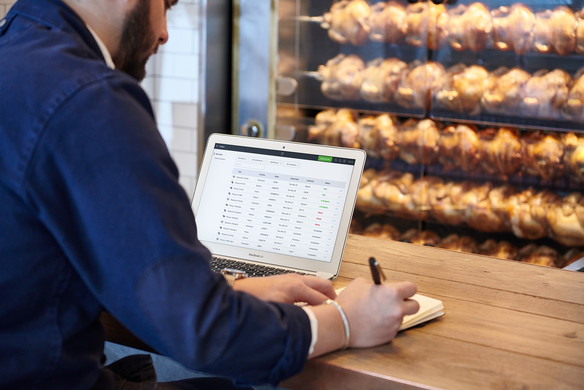One food wholesaler is literally going bananas as demand from restaurants and schools has evaporated in the wake of the COVID-19 pandemic. M. Levin and Co., a fruit and vegetable wholesaler in Philadelphia, is feeling the volatility of a restaurant supply chain that has been rattled as the result of government measures to protect both consumers and workers from COVID-19.
The pandemic has disrupted not only restaurants but also food distributors and producers. Levin, for example, usually supplies boxes of loose bananas for use in restaurant and school kitchens. But declining restaurant sales and closed schools have meant less demand for bananas and other fresh produce, as well as for just about everything else used by commercial kitchens.
The sudden drop in demand is being felt all the way at the beginning of the restaurant supply chain. The Wall Street Journal reported that producers have been grappling with a glut of commodities, such as milk, eggs, and produce. Even as some grocery stores have experienced shortages, farmers who normally supply restaurants in bulk are struggling to find a market for their products.
Coping with a new reality
Although some restaurants have gone dark, others have continued operating by offering takeout, curbside pickup, and/or delivery options. Many restaurants are also pivoting to groceries. Because restaurants rely on different supply chains than grocers and other retailers do, they can access staples that are running low at grocery stores, such as flour and yeast.
While most supply chains have remained strong in the wake of the pandemic, you need to be strategic in how you cope with the current situation. That means actively managing existing supply chains, and looking forward to when you can resume normal operations.
Managing uncertainty
Restaurants were forced to be reactive with the sudden closure of dining rooms across the country. Now, in addition to not knowing when you will be able to reopen, you have to maintain connectivity to supply chains that can facilitate scaled-down operations today and business-as-usual in the future. Here are some suggestions for how to handle the uncertainty.
Source online
One trend that is expected to grow as the result of the pandemic-related disruption is online sourcing. Even before COVID-19 struck, restaurants were sourcing from online sellers. In fact, according to Restaurant Business, 40% of restaurateurs already order supplies at least once a month from online sources, such as Amazon.
While you need to maintain your relationships with traditional suppliers, online distributors may be critical once governments give the all-clear to allow dining rooms to reopen.
When that happens, demand will surge and distributors will go from slow to swamped. Having alternative supply sources, including online suppliers and even direct relationships with producers, can give you a competitive advantage during the demand surge that will result from a return to normal operations.
Still, with much of the supply controlled by major food distribution companies, you also need to protect that all important last-mile lifeline between warehouse and kitchen.
Plan for the future
The old cliché “necessity is the mother of invention” is particularly apropos when it comes to the predicament faced by restaurants that are working to stay open without a clear timeline for life returning to whatever “the new normal” will be. Either way, everyone will have to adapt to a new reality.
You can use the current lull in operations to adjust business plans and prepare for a future that may require permanent changes. The National Restaurant Association (NRA), in its “Blueprint for Recovery,” says that restaurants should address the following:
- Review your business plans and financial infrastructure.
- Learn about and apply for financial relief, if you need it.
- Prepare for rehiring and retraining workers, if needed.
- Plan for what is likely to be a new era of social distancing and increased health and safety requirements. This may include the need to modify facilities, add the use of personal protective equipment and disposable products, and/or utilize enhanced sanitization practices.
Use technology
Technology may accelerate the pace of change in the restaurant supply chain of the future. Ben Deda, CEO of online marketplace FoodMaven, told PYMTS.com that pandemic-related disruption has underscored the need for an agile supply chain supported by tech-driven logistics, and an increase in both online buying and consumer-facing eCommerce.
That means you need to invest in B2C eCommerce technology that will support both your supply-side operations and your consumer-facing business.
You also have to be ready for producers to shift toward a lean manufacturing mindset in which production and supply is calibrated closely to demand. Supply chain intermediaries will reflect a just-in-time approach to delivering orders. Ultimately, that could reduce the amount of waste in the food supply chain.
But, in the short term, it could also constrain the ability for restaurant kitchens to get needed supplies at the last minute. This underscores the need for you to develop alternative supply sources to ensure you can keep your pantry full.
Looking ahead, according to another PYMTS.com report, you also need to adjust to supply chain disruptions during the pandemic and prepare for more flexibility in the future.
“When the current black swan finally departs and restaurants begin to reopen,” says Andrew Robbins, CEO of Paytronix, “we hope those that truly invested in developing strong relationships will survive.”
![]()












